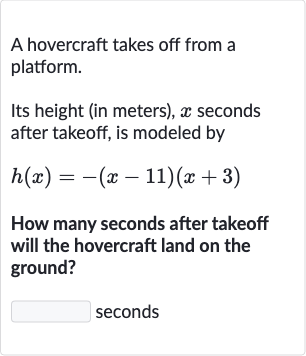Full solution
Q. A hovercraft takes off from a platform. Its height (in meters), seconds after takeoff, is modeled by How many seconds after takeoff will the hovercraft land on the ground?
- Given height function: We are given the height function . To find out when the hovercraft will land on the ground, we need to determine when the height is equal to .
- Set height function equal: Set the height function equal to zero and solve for :
- Expand and simplify equation: Expand the equation:
- Solve quadratic equation: Simplify the equation by combining like terms:
- Substitute values into formula: To find the values when the hovercraft is on the ground, we need to solve the quadratic equation . This can be done by factoring, completing the square, or using the quadratic formula. Since the equation does not factor easily, we will use the quadratic formula: , where , , and .
- Calculate discriminant: Substitute the values of , , and into the quadratic formula:
- Calculate square root: Calculate the discriminant (the part under the square root):Discriminant =
- Substitute square root: Take the square root of the discriminant:
- Calculate possible solutions: Substitute the square root back into the quadratic formula:
- Identify meaningful solution: Calculate the two possible solutions for :
- Identify meaningful solution: Calculate the two possible solutions for :Since time cannot be negative, the solution seconds is not physically meaningful for this problem. Therefore, the hovercraft will land on the ground seconds after takeoff.

